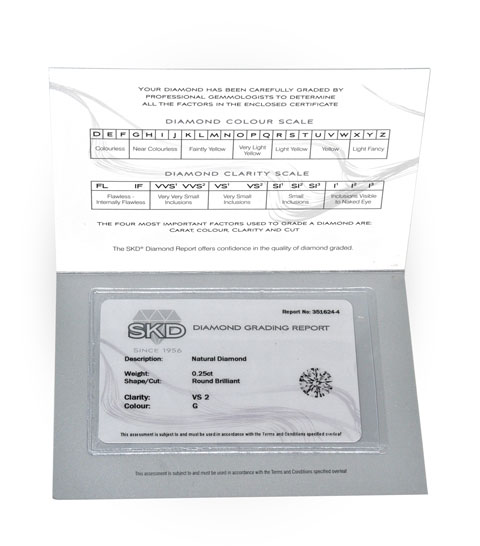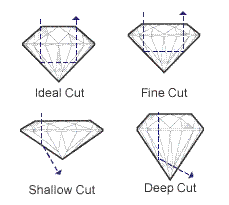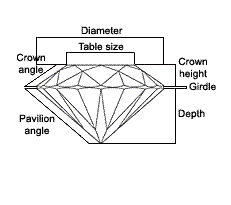
Now the SKD Certificate has been launched to bring our expertise to the public and address the growing concern over frequent misrepresentation of diamond qualities. Consumers need to be assured that the diamond they are buying is the same as that advertised, something that can only be done through professional assessment.
To the untrained eye, two diamonds that appear identical can actually be of completely different qualities, and therefore values. Even the smallest of differences in grade can effect the diamond´s worth.
The skill of grading diamonds comes with years of experience and acquired knowledge and our aim is to be able to use these expertise to give consumers confidence when buying. Our professional graders are dedicated to providing an accurate and reliable report using the most up-to-date technology. Each diamond we scrutinise undergoes an exacting process of rigorous and stringent tests, before grading.
The SKD certificate is simply the culmination of this work which attests to the diamond´s authenticity based on internationally recognised standards.
This means that if your jewellery purchase is accompanied by an SKD Certificate, you can trust in the quality of the diamonds.

The name “diamond” derives from the Greek word “Adamas” meaning unconquerable, suggesting the eternity of love. Since ancient Greece, diamonds have been the traditional symbol of love and commitment. Diamonds are generally perceived to express not only love but flawless, timeless and astonishing beauty.
A diamond is the hardest of all gemstones found in nature. All diamonds are precious but no two stones are the same even though they may look identical to the naked eye. Those possessing the highest quality are the rarest and most valuable.
To understand these differences is to understand what is commonly known as the 4C’s: Cut, Clarity, Colour and Carat Weight which are used to classify the rarity of diamonds. Light is the element that ignites a diamond brilliance, fire and ultimate beauty. The combination will help to explain why one diamond can appear even more beautiful than another.


Cut is probably the most important and most challenging. It is the only characteristic influenced by man; the other three are dictated by nature. A well cut diamond causes the fiery sparkle. For a Round brilliant diamond, a good cut releases the “fire” and “brilliance” of a diamond through the proportions of its 57 or 58 facets ( tiny planes to create angles) allowing the maximum of light to be reflected through the diamond.
In order to maximise this fire and brilliance, a diamond cutter must place each of the stone’s facets and angles, which acts as light dispersing mirrors, in exact geometric relation to one another.
Evaluating a diamond’s colour for grading purposes is done by measuring the degree to which a diamond approaches colourless. While most diamonds appear white, many of them display hints of colour barely discernible to the naked eye. The closer a diamond approaches colourless, the rarer and more valuable the stone.
A diamond is formed by a crystallization of the element carbon under pressure. In most diamonds not all the carbon crystallizes, so small traces of non-crystallized carbon remain. These traces of remaining carbon are called “inclusions”. The degree to which a diamond is free from naturally occurring inclusions determines its clarity rating.
In most cases before these inclusions become apparent to the naked eye, they often require magnification under a powerful 10 x jeweller’s magnification lens, sometime referred as a “loupe”. The fewer and smaller the inclusions the rarer the stone and the more beautiful the brillance” resulting from the light passing through and out of the diamond.
Diamond weight is stated in carats and therefore the size of a diamond. One carat is divided into 100 points; so for example, a diamond weighing 50 points is half a carat or 0.50 carats. Diamonds over 1 carat are particularly rare. It is estimated that less than 5% of gem quality diamonds achieve this magic weight once they are cut and polished making them more desirable and inevitably more expensive.
If you wish to contact us, you will find our offices at:
SK Diamonds, London EC1